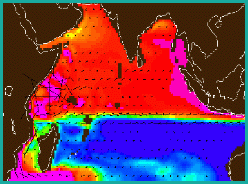Interannual Variability in the Indian Ocean Wind-Driven Circulation 1977-1992

A
numerical model of wind-driven Indian Ocean circulation and the
wind data
used to drive it are analyzed to study the patterns of interannual variability
in both data sets and their relationship. The variability is quantified by an
EOF analysis. The first EOF of the model circulation accounts for 48.2% of the
variation in upper layer thickness and reveals a basin-scale redistribution of
mass north and south of 10��S. The second and third EOFs of the model
circulation account for 14.6% and 9.7% of the variation in upper layer
thickness, respectively, and reveal an east/west redistribution of mass south of
5��S between 70��E and 90��E. Together, the first three EOFs account for 71.4% of
the total variance in upper layer thickness. Reconstructing the data from these
first three EOFs, a propagating pattern emerges, that connects the equatorial
wave guide with higher latitudes in both hemispheres. The perturbation
propagates cyclonically in both hemispheres with a time scale of approximately
10 years. The wind EOFs and the average zonal winds reveal an increase in the
trade winds and equatorial westerlies from 1983-1985.
We hypothesize that the basin-scale pattern seen in the model output is
triggered by the increase in the trade winds and equatorial westerlies from
1983-1985. This increase will strengthen the East African Coastal Current and
the Somali Current and generate variations in a superposition of equatorial and
extra-tropical planetary waves. These waves will reduce the north/south slope
in upper layer thickness at the Indonesian throughflow region, thus weakening
the throughflow. This effect is magnified because the equatorial Indian Ocean
is approximately resonant at the semiannual period. The effects propagate from
the equatorial wave guide to higher latitudes in both hemispheres through
reflection at the eastern boundary as westward-propagating Rossby waves and
poleward propagating coastal Kelvin waves. Interaction of these reflected waves
with the open boundary representing the Indonesian passages at 10��S to 15��S may
lead to marked difference in the oceanic response to the north and south of
10��SS.
To request a copy write:
[email protected]





[email protected]



